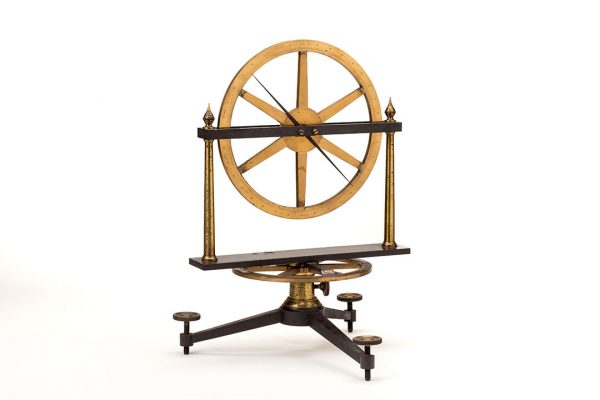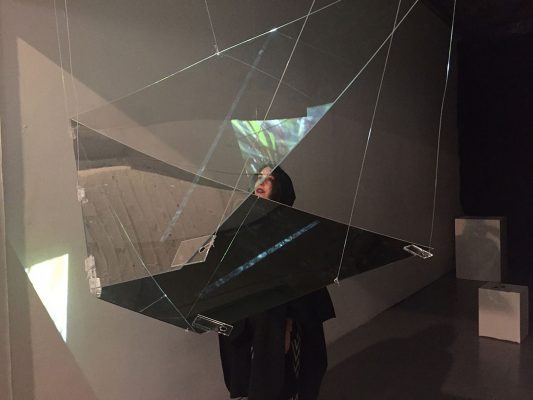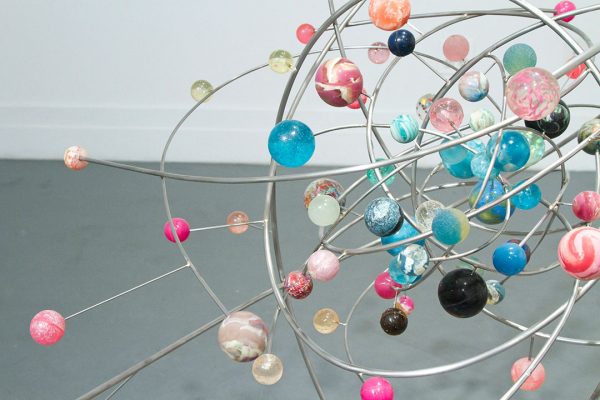Probability & Uncertainty
January 13th – June 17th, 2018
Curated by Julie Lohnes, Curator of Art Collections & Exhibitions

Kirsten Thoen, Ice Fractal #1, 2014, ed. 3, digital C-prints on Dur-A-Flex and Plexiglas, 25 x 21 x 21 inches
As Union College embarked on the new building and renovation project for our Science and Engineering departments last year, the moment seemed well-suited to re-examine the historic scientific instruments held in the Union College Permanent Collection. This culminated with the exhibition Probability & Uncertainty, featuring more than 30 instruments, juxtaposed with the works of six contemporary female artists creating with scientific themes.
As a curator of visual arts, I initially approached the selection of instrumentation as a purely formal venture by reacting to the materiality and shapes of each object and how they might relate to each other spatially and visually, rather than their mechanisms or purpose for teaching in the 1800s. Building on their material relationships (wood, metal, glass) and grouping similarly shaped objects together (octant, sextant, sector), I established an order which I used as a springboard of entry into the world of 19th century optics, navigation, and mathematics.
My immersion into the lives of the scientists, makers, and inventors, and the specialized field of historic scientific apparatus felt overwhelming. I quickly realized that one could spend an entire curatorial career researching a single branch of science through its instrumentation. Therefore, for the purpose of this catalogue, each instrument pictured has a brief description and, in some cases, general information about the scientist, maker, or inventor.
Combining these objects of science with the contemporary female artists was a deliberate act: I was taking the apparatus out of history and situating them within the present day. By presenting connections between historic fields of inquiry and the themes used by the contemporary artists, this exhibition seeks to emphasize shared impulses found in the humanities and sciences, then and now. These connections and fields are intertwined metaphorically, and tangibly, within these beautiful objects.
Surveying and navigation can be seen within Kirsten Kay Thoen’s explorations of ice flows, geology, river silt, and fractals. The African fractals and algorithms of Nettrice Gaskins’ video installation relate to Théodore Olivier’s geometric models. Carter Hodgkin’s animations of particle collisions compare with the active color of Crookes and Geissler tubes. Jessie Henson’s celestial bodies hark back to orreries of the 1700s-1800s. And both Aimée Burg and Audrey Wilson create fictitious apparatus reminiscent of the inventions from the era.
In the end, I researched very few of the objects from our collection of more than 300 historical scientific instruments: those which intrigued me visually, and led to a respect of makers – Burt, Butterfield, Crookes, Geissler, Duboscq, Nörremberg – for their originality of design and the utility of their apparatus, which spawned and still touch so many fields of inquiry today. These include the studio arts, lighting, photography, and quantum and modern-day physics.
Along the way, I had a number of guides who patiently listened to my novice questions about physics and the instruments themselves.
At the National Museum of American History, Smithsonian Institution in Washington, D.C., curators were generous of spirit, time, and enthusiasm, and answered my questions about the apparatus in Union’s collection, as I looked through their collection. I am grateful to the following members of the Division of Medicine and Science: Deborah Warner, Curator, Physical Sciences Collection; Peggy Kidwell, Curator, Mathematics Collection; and Harold Wallace, Associate Curator, Electricity Collections. For assistance, thanks also go to: Roger E. Sherman, Associate Curator, Division of Medicine and Science; Kay Peterson, Archives Center, National Museum of American History; and Erin Clements Rushing, Outreach Librarian, Smithsonian Libraries. Lastly, a very special thank you to Dr. Ivan Selin.
At Union, there are many who assisted with this exhibition, including Kevin Trigo (Class of 2019), who explained classic physics and other topics, which inspired the title of the exhibition. Professor of Physics Seyfollah Maleki proofed all things “physics” included in this catalogue. Special thanks to John Sheehan, Machinist/Technician, of the Physics and Astronomy Department, for managing the orrery move to the gallery. Additional thanks go to India Spartz, Sarah Oswald, and Marlaine DesChamps of Special Collections and Archives.
Funding for a research trip to the National Museum of American History, Smithsonian Institution, Washington, D.C., as well as the maker workshop event, was provided by a Mellon Foundation grant as part of the “Our Shared Humanities” college-wide initiative.
The following departments generously co-sponsored this exhibition and its corresponding events: Geology; Gender, Sexuality and Women’s Studies; Interdisciplinary Studies; Mathematics; Office of Diversity and Inclusion; Physics and Astronomy; and Visual Arts.
– Julie Lohnes, Curator of Art Collections & Exhibitions
Opening Reception
Wednesday, January 24th, 2018
5:00 – 6:30 PM
At the Nott Memorial
Olivier Model Demo Day
Thursday, February 8th, 2018
12:55 – 1:45 PM
Nott Memorial
Artist Talk & Reception: Nettrice Gaskins
Wednesday, April 11th, 2018
5:00 – 6:30 PM
Nott Memorial
Maker Workshop: Contemporary Art Intersections with Nettrice Gaskins
Thursday, April 12th, 2018
12:55 – 1:45 PM
Feigenbaum Center for the Visual Arts, Room 101









